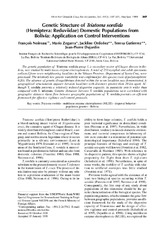Mostrar el registro sencillo del ítem
Genetic structure of Triatoma sordida (Hemiptera: Reduviidae) domestic populations from Bolivia : application on control interventions
| dc.contributor.author | Noireau, François | |
| dc.contributor.author | Zegarra, Mario | |
| dc.contributor.author | Ordoñez, Jackline | |
| dc.contributor.author | Gutiérrez, Teresa | |
| dc.contributor.author | Dujardin, Jean-Pierre | |
| dc.date.accessioned | 2017-10-31T18:16:30Z | |
| dc.date.available | 2017-10-31T18:16:30Z | |
| dc.date.issued | 1999 | |
| dc.identifier.uri | http://repositorio.umsa.bo/xmlui/handle/123456789/13218 | |
| dc.description.abstract | The genetic population of Triatoma sordida group 1, a secondary vector of Chagas disease in Bolivia, was studied by multi-locus enzyme electrophoresis. A total of 253 nymphal and adult specimens collected from seven neighbouring localities in the Velasco Province, Department of Santa Cruz, were processed. The relatively low genetic variability was confirmed for this species (rate of polymorphism: 0.20). The absence of genetic disequilibrium detected within the seven localities was demonstrated. A geographical structuration appears between localities with distances greater than 20 km apart. Although T. sordida presents a relatively reduced dispersive capacity, its panmictic unit is wider than compared with T. infestans. Genetic distances between T. sordida populations were correlated with geographic distance. Gene flow between geographic populations of T. sordida provides an efficient framework for effective vigilance and control protocols. | es_ES |
| dc.language.iso | en | es_ES |
| dc.publisher | Mem. Inst. Oswaldo Cruz | es_ES |
| dc.subject | TRIATOMA SORDIDA | es_ES |
| dc.subject | MULTILOCUS ENZYME ELECTROPHORESIS | es_ES |
| dc.subject | COMPORTAMIENTO DE DISPERSIÓN | es_ES |
| dc.subject | GENÉTICA DE POBLACIONES | es_ES |
| dc.subject | BOLIVIA | es_ES |
| dc.title | Genetic structure of Triatoma sordida (Hemiptera: Reduviidae) domestic populations from Bolivia : application on control interventions | es_ES |
| dc.type | Article | es_ES |

